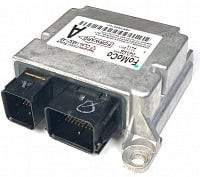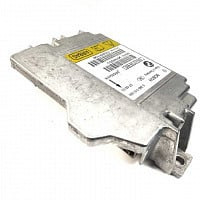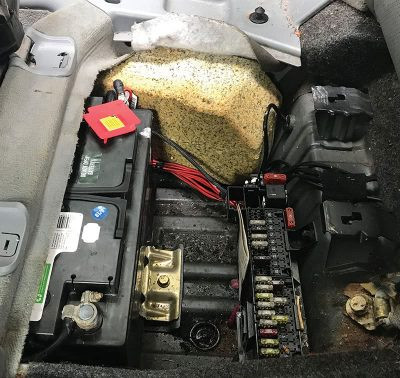What Parameters Are Important When Diagnosing the Airbag System?

Airbag system diagnostics are crucial for vehicle safety and should be performed with precision. What parameters are important when diagnosing the airbag system? Key parameters include sensor data, voltage levels, resistance values, and diagnostic trouble codes (DTCs). For expert airbag repair solutions, visit CARDIAGTECH.NET to ensure safety and reliability. Address problems with seat belt pretensioners and airbag control unit malfunctions.
1. Understanding the Airbag System and Its Importance
Modern vehicles rely on the airbag system, a crucial part of the Supplemental Restraint System (SRS), to protect passengers during collisions. These systems use advanced technology to detect impacts and deploy airbags in milliseconds, minimizing injury. Understanding how these systems work and the importance of each component is critical for accurate diagnosis and repair.
1.1 How the Airbag System Functions to Ensure Safety
Airbags deploy in various types of collisions, and their effectiveness is rooted in several key principles. Upon detecting an impact, sensors measure the severity and send signals to the airbag control unit (ECU). This unit then determines which airbags to deploy, managing the timing and inflation rate. Seat belt pretensioners also activate to secure occupants before the airbags inflate, maximizing protection. According to research from the National Highway Traffic Safety Administration (NHTSA), a properly functioning SRS can reduce driver fatalities in frontal crashes by up to 30%. Therefore, maintaining the functionality of every part of the system is essential for passenger safety.
SRS Airbag System Components
1.2 Identifying the Core Components of the Airbag System
The airbag system consists of several interconnected components:
- Airbag Modules: These contain the folded airbags and inflators, which release gas to rapidly inflate the airbags.
- Control Unit (ECU): The brain of the system, it processes data from sensors to determine airbag deployment.
- Impact Sensors: These detect sudden deceleration and relay signals to the ECU.
- Seat Belt Pretensioners: These tighten the seat belts to hold occupants securely in place.
- Clock Spring: This maintains the electrical connection to the airbag in the steering wheel while allowing it to turn.
Each component plays a vital role, and any malfunction can compromise the entire system.
1.3 Understanding the Critical Need for Accurate Diagnostics
Can airbag deployment be prevented? Yes, but accurate diagnostics are essential for ensuring the system works correctly. Faulty sensors, damaged wiring, or a malfunctioning control unit can cause the system to fail during a collision. Proper diagnostics involve checking each component, reading diagnostic trouble codes (DTCs), and verifying the system’s functionality after repairs. Regular checks and precise diagnostics help maintain the reliability of the airbag system, ensuring passenger safety. For thorough diagnostics, trust the expertise at CARDIAGTECH.NET.
2. Essential Parameters for Diagnosing the Airbag System
Diagnosing an airbag system requires a systematic approach, focusing on specific parameters to identify faults. Key parameters include sensor data, voltage levels, resistance values, and diagnostic trouble codes (DTCs). Monitoring these parameters provides insights into the system’s health and helps pinpoint the source of any problems.
2.1 Interpreting Sensor Data for Accurate Diagnostics
Airbag systems rely on various sensors to detect impact forces and determine the severity of a collision.
- Accelerometer Sensors: These measure the rate of deceleration during an impact.
- Impact Sensors: Located in the front and sides of the vehicle, these detect the force of a collision.
- Occupancy Sensors: These determine if a seat is occupied and adjust airbag deployment accordingly.
Interpreting the data from these sensors involves using a diagnostic scan tool to read real-time values. According to a study by the University of Michigan Transportation Research Institute, faulty sensor readings account for approximately 20% of airbag system malfunctions. Analyzing sensor data helps identify whether a sensor is providing accurate information or if it needs replacement.
 Airbag System Sensors
Airbag System Sensors
2.2 Monitoring Voltage Levels in the Airbag System
Voltage levels are critical for the proper functioning of the airbag system. The airbag control unit (ECU) requires a stable voltage supply to operate correctly, and sensors and actuators need specific voltage levels to function effectively.
- Power Supply Voltage: Check the voltage at the ECU to ensure it is within the manufacturer’s specified range (typically 12-14 volts).
- Sensor Voltage: Verify that sensors are receiving the correct voltage levels, as indicated in the service manual.
- Actuator Voltage: Ensure that the actuators (such as airbag inflators) are receiving the necessary voltage to trigger deployment.
Monitoring voltage levels can reveal issues such as short circuits, open circuits, or voltage drops that can affect system performance.
2.3 Assessing Resistance Values in Airbag Circuits
Resistance values in airbag circuits must be within specified ranges to ensure proper functionality. High resistance can indicate corroded connectors or damaged wiring, while low resistance can signal a short circuit.
- Wiring Resistance: Measure the resistance of the wiring between the sensors, ECU, and actuators to identify any breaks or shorts.
- Squib Resistance: Check the resistance of the squib (the ignition device in the airbag inflator) to ensure it is within the manufacturer’s specified range.
According to research from the Society of Automotive Engineers (SAE), incorrect resistance values are a common cause of airbag system malfunctions, accounting for about 15% of issues.
2.4 Decoding and Addressing Diagnostic Trouble Codes (DTCs)
Diagnostic Trouble Codes (DTCs) are codes stored in the airbag control unit (ECU) when a fault is detected. These codes provide valuable information about the nature and location of the problem.
- Using a Scan Tool: Connect a diagnostic scan tool to the vehicle’s OBD-II port to read the stored DTCs.
- Interpreting DTCs: Consult the vehicle’s service manual or a reliable DTC database to understand the meaning of each code.
- Addressing DTCs: Follow the diagnostic procedures outlined in the service manual to troubleshoot and repair the identified faults.
Common DTCs include sensor failures, wiring issues, and control unit malfunctions. Addressing DTCs promptly and accurately is essential for restoring the airbag system to proper working condition. For expert assistance with DTCs, contact CARDIAGTECH.NET at +1 (641) 206-8880.
3. Step-by-Step Diagnostic Procedures for Airbag Systems
Diagnosing airbag systems requires a systematic approach to ensure accuracy and safety. Following a step-by-step procedure helps identify the root cause of any issues and ensures effective repairs.
3.1 Initial Inspection and Safety Precautions
Before beginning any diagnostic work, it is essential to perform a thorough initial inspection and take necessary safety precautions.
- Visual Inspection: Check for any visible damage to the airbag modules, sensors, and wiring.
- Battery Disconnection: Disconnect the negative terminal of the battery and wait at least 10-15 minutes to allow the system to discharge.
- Safety Gear: Wear safety glasses and gloves to protect against accidental deployment and potential hazards.
Following these initial steps minimizes the risk of accidental airbag deployment and ensures a safe working environment.
3.2 Retrieving and Analyzing Diagnostic Trouble Codes (DTCs)
The next step involves retrieving and analyzing Diagnostic Trouble Codes (DTCs) stored in the airbag control unit (ECU).
- Connecting the Scan Tool: Connect a diagnostic scan tool to the vehicle’s OBD-II port.
- Reading DTCs: Use the scan tool to read and record any stored DTCs.
- Analyzing DTCs: Consult the vehicle’s service manual or a reliable DTC database to understand the meaning of each code.
Analyzing DTCs provides valuable insights into the nature and location of the problem, guiding the diagnostic process.
3.3 Testing Sensor Functionality and Signal Integrity
After analyzing DTCs, the next step is to test the functionality of the airbag system sensors and verify the integrity of their signals.
- Accelerometer Sensors: Use the scan tool to monitor the real-time data from the accelerometer sensors while simulating different impact conditions.
- Impact Sensors: Test the impact sensors by gently tapping them and observing the signal response on the scan tool.
- Wiring Continuity: Use a multimeter to check the continuity of the wiring between the sensors and the ECU, ensuring there are no breaks or shorts.
Testing sensor functionality and signal integrity helps identify faulty sensors or wiring issues that may be affecting system performance.
3.4 Verifying Voltage and Resistance Values in Circuits
Verifying voltage and resistance values in the airbag system circuits is essential for identifying electrical issues.
- Voltage Checks: Use a multimeter to check the voltage at various points in the circuits, ensuring they are within the manufacturer’s specified range.
- Resistance Checks: Measure the resistance of the wiring and components, comparing the values to the specifications in the service manual.
Identifying voltage drops or incorrect resistance values helps pinpoint electrical faults that may be causing system malfunctions.
3.5 Performing Component-Level Diagnostics
If the previous steps do not reveal the source of the problem, it may be necessary to perform component-level diagnostics.
- Airbag Module Testing: Carefully inspect the airbag modules for any signs of damage or corrosion.
- ECU Testing: If the ECU is suspected of being faulty, it may be necessary to send it to a specialized repair service for testing and repair.
- Seat Belt Pretensioner Testing: Inspect the seat belt pretensioners for proper operation and ensure they are functioning correctly.
Component-level diagnostics can help identify specific parts that need replacement or repair. CARDIAGTECH.NET offers expert SRS repair services for a wide range of components.
3.6 Confirming Repairs and Clearing Codes
After completing the necessary repairs, it is essential to confirm that the system is functioning correctly and clear any stored DTCs.
- Recheck DTCs: Use the scan tool to read the DTCs again, ensuring that all previously stored codes have been resolved.
- System Testing: Perform a comprehensive system test to verify that all components are functioning correctly.
- Clearing Codes: Clear any remaining DTCs from the ECU.
Confirming repairs and clearing codes ensures that the airbag system is fully operational and ready to protect passengers in the event of a collision.
4. Common Issues Encountered During Airbag System Diagnostics
During airbag system diagnostics, technicians often encounter a variety of common issues. Understanding these issues and how to address them is essential for effective repairs.
4.1 Identifying Faulty Sensors and Their Impact
Faulty sensors are a common cause of airbag system malfunctions. Sensors can fail due to physical damage, corrosion, or electrical issues.
- Accelerometer Sensors: These may provide inaccurate readings or fail to detect impact forces.
- Impact Sensors: These may not trigger properly during a collision.
- Occupancy Sensors: These may incorrectly detect whether a seat is occupied, affecting airbag deployment.
Replacing faulty sensors with new, OEM-quality parts is essential for restoring proper system functionality.
4.2 Recognizing Wiring Problems and Corrosion Issues
Wiring problems and corrosion can disrupt the electrical signals within the airbag system, leading to malfunctions.
- Broken Wires: These can interrupt the flow of electricity, preventing sensors and actuators from functioning correctly.
- Corroded Connectors: Corrosion can increase resistance in the circuits, affecting signal strength and reliability.
- Short Circuits: These can cause unintended airbag deployment or system failures.
Repairing or replacing damaged wiring and corroded connectors is essential for maintaining the integrity of the airbag system.
 Wiring Issues
Wiring Issues
4.3 Addressing Control Unit (ECU) Malfunctions
The airbag control unit (ECU) is the brain of the system, and malfunctions can have a significant impact on system performance.
- Software Issues: These can cause the ECU to misinterpret sensor data or fail to trigger airbag deployment.
- Hardware Failures: Internal component failures can prevent the ECU from functioning correctly.
- Crash Data Storage: After a collision, the ECU stores crash data that may need to be cleared or reset.
Addressing ECU malfunctions may involve reprogramming the unit, replacing faulty components, or resetting the crash data. CARDIAGTECH.NET offers professional airbag module reset services to restore ECU functionality.
4.4 Resolving Seat Belt Pretensioner Problems
Seat belt pretensioners are an integral part of the airbag system, and problems with these devices can affect overall safety.
- Locked Pretensioners: After a collision, the pretensioners may lock up, preventing the seat belts from retracting.
- Damaged Mechanisms: Physical damage to the pretensioner mechanisms can prevent them from functioning correctly.
- Electrical Issues: Electrical problems can prevent the pretensioners from deploying during a collision.
Resolving seat belt pretensioner problems may involve repairing or replacing the devices to ensure they function properly in the event of a crash.
5. Advanced Diagnostic Techniques for Complex Airbag Issues
For complex airbag issues that cannot be resolved with basic diagnostic procedures, advanced techniques may be necessary. These techniques involve specialized tools and expertise to identify and address the root cause of the problem.
5.1 Utilizing Oscilloscopes for Signal Analysis
Oscilloscopes are valuable tools for analyzing the electrical signals within the airbag system. They can display the voltage and timing of signals, providing insights into the performance of sensors, actuators, and the ECU.
- Analyzing Sensor Signals: Use an oscilloscope to monitor the signals from the accelerometer sensors and impact sensors, looking for any anomalies or distortions.
- Verifying Actuator Signals: Check the signals sent to the airbag inflators and seat belt pretensioners to ensure they are receiving the correct commands.
- Identifying Intermittent Issues: Oscilloscopes can capture intermittent signal problems that may not be detectable with a scan tool or multimeter.
Utilizing oscilloscopes for signal analysis can help identify subtle issues that may be affecting airbag system performance.
5.2 Performing In-Depth Wiring Harness Inspections
A thorough inspection of the wiring harness is essential for identifying any hidden damage or corrosion that may be affecting the airbag system.
- Checking for Breaks: Carefully inspect the wiring for any signs of breaks or cuts.
- Examining Connectors: Check the connectors for corrosion, loose connections, or damaged pins.
- Testing Continuity: Use a multimeter to test the continuity of each wire in the harness, ensuring there are no breaks or shorts.
In-depth wiring harness inspections can reveal issues that may not be apparent during a visual inspection.
5.3 Using Specialized Diagnostic Software
Specialized diagnostic software can provide advanced testing and diagnostic capabilities for airbag systems.
- OEM Software: Original Equipment Manufacturer (OEM) software provides access to detailed diagnostic information and testing procedures specific to the vehicle.
- Aftermarket Software: Aftermarket diagnostic software can offer a wide range of features and capabilities for diagnosing airbag systems in various makes and models.
Using specialized diagnostic software can help technicians perform advanced testing, calibration, and programming of airbag system components.
5.4 Seeking Expert Consultation for Difficult Cases
In some cases, diagnosing and repairing complex airbag issues may require the expertise of a specialist.
- Contacting the Manufacturer: Consult the vehicle manufacturer for technical support and diagnostic information.
- Seeking Professional Assistance: Contact a specialized airbag repair service, such as CARDIAGTECH.NET, for expert assistance and solutions.
Seeking expert consultation can provide valuable insights and guidance for resolving difficult airbag system problems. Contact CARDIAGTECH.NET at +1 (641) 206-8880 for professional SRS repair services.
6. Maintaining Airbag System Integrity After Repairs
After completing airbag system repairs, it is essential to take steps to maintain the integrity of the system and ensure its continued reliability.
6.1 Following OEM Repair Procedures
Following Original Equipment Manufacturer (OEM) repair procedures is critical for ensuring that repairs are performed correctly and meet the manufacturer’s specifications.
- Using Service Manuals: Consult the vehicle’s service manual for detailed repair procedures and specifications.
- Following Guidelines: Adhere to the manufacturer’s guidelines for component replacement, torque settings, and wiring repairs.
Following OEM repair procedures helps maintain the integrity of the airbag system and ensures its long-term reliability.
6.2 Verifying System Functionality Through Testing
After completing repairs, it is essential to verify that the airbag system is functioning correctly through comprehensive testing.
- Diagnostic Scan: Perform a diagnostic scan to ensure that all DTCs have been resolved and the system is functioning properly.
- Simulated Deployment: If possible, perform a simulated deployment test to verify that the airbags deploy correctly under simulated collision conditions.
- Visual Inspection: Conduct a final visual inspection to ensure that all components are properly installed and secured.
Verifying system functionality through testing ensures that the airbag system is ready to protect passengers in the event of a collision.
6.3 Emphasizing the Importance of Regular Inspections
Regular inspections of the airbag system are essential for identifying and addressing any potential issues before they become major problems.
- Scheduled Maintenance: Include airbag system inspections as part of the vehicle’s scheduled maintenance program.
- Visual Checks: Perform regular visual checks of the airbag modules, sensors, and wiring for any signs of damage or corrosion.
- Diagnostic Scans: Conduct periodic diagnostic scans to check for any stored DTCs or system malfunctions.
Emphasizing the importance of regular inspections can help maintain the integrity of the airbag system and ensure its continued reliability.
6.4 Seeking Professional Airbag System Maintenance
Professional airbag system maintenance services can provide comprehensive inspections, testing, and repairs to ensure the system is functioning optimally.
- Certified Technicians: Seek out certified technicians with specialized training and experience in airbag system maintenance.
- Advanced Equipment: Ensure that the maintenance service uses advanced diagnostic equipment and tools for accurate testing and repairs.
- Comprehensive Services: Look for maintenance services that offer comprehensive inspections, testing, and repairs for all components of the airbag system.
Seeking professional airbag system maintenance can help maintain the integrity of the system and ensure its continued reliability. CARDIAGTECH.NET offers expert SRS repair services to keep your airbag system in top condition. Visit us at 276 Reock St, City of Orange, NJ 07050, United States, or contact us via WhatsApp at +1 (641) 206-8880, or visit our website at CARDIAGTECH.NET.
7. The Role of CARDIAGTECH.NET in Airbag System Diagnostics and Repair
CARDIAGTECH.NET plays a vital role in providing expert airbag system diagnostics and repair services. Our comprehensive services, experienced technicians, and commitment to quality make us a trusted partner for vehicle owners and repair shops.
7.1 Overview of Services Offered by CARDIAGTECH.NET
CARDIAGTECH.NET offers a wide range of services for airbag system diagnostics and repair, including:
- Diagnostic Scanning: Accurate identification of issues within the SRS system.
- Airbag Module Reset: Restoring factory settings for optimal performance.
- Seat Belt Pretensioner Repair: Ensuring functionality during impact.
- Component Replacement: Supplying and installing certified OEM-quality components.
- Wiring Repairs: Addressing electrical faults to maintain system integrity.
Our services are designed to meet the diverse needs of our clients, ensuring that their airbag systems are functioning optimally.
7.2 Highlighting Expertise and Experience
Our team of certified technicians possesses extensive experience and expertise in airbag system diagnostics and repair. We stay up-to-date with the latest technologies and techniques to provide accurate and effective solutions.
- Certified Technicians: Our technicians hold certifications from recognized industry organizations, demonstrating their competence and knowledge.
- Continuous Training: We invest in continuous training to ensure that our technicians are equipped with the latest skills and knowledge.
- Proven Track Record: Our proven track record of successful repairs and satisfied clients speaks to our commitment to quality and excellence.
7.3 Showcasing Commitment to Quality and Safety
At CARDIAGTECH.NET, we are committed to providing high-quality services that prioritize safety. We adhere to strict quality control standards and use only certified OEM-quality components to ensure the reliability and effectiveness of our repairs.
- Quality Control: We implement rigorous quality control procedures to ensure that every repair meets our high standards.
- OEM Components: We use only certified OEM-quality components to ensure the reliability and effectiveness of our repairs.
- Safety First: We prioritize safety in all our operations, following strict safety protocols and guidelines.
7.4 Providing Accessible Support and Consultation
CARDIAGTECH.NET is committed to providing accessible support and consultation to our clients. We offer a range of resources and support channels to assist with airbag system diagnostics and repair.
- Online Resources: Our website features a wealth of information, including diagnostic tips, repair procedures, and FAQs.
- Technical Support: Our technical support team is available to answer questions and provide guidance on airbag system issues.
- Consultation Services: We offer consultation services to help clients diagnose complex airbag problems and develop effective repair strategies.
Contact CARDIAGTECH.NET at +1 (641) 206-8880 for expert airbag system diagnostics and repair services. Visit our website at CARDIAGTECH.NET for more information.
8. What Parameters Are Important When Diagnosing The Airbag System: Call to Action
What parameters are important when diagnosing the airbag system? Diagnosing airbag systems requires careful attention to sensor data, voltage levels, resistance values, and diagnostic trouble codes (DTCs) to ensure passenger safety. At CARDIAGTECH.NET, we understand the critical nature of these systems and offer expert services to keep them functioning perfectly. Don’t risk compromising your safety with faulty airbags. Contact us today at +1 (641) 206-8880 or visit CARDIAGTECH.NET for reliable diagnostics and repair solutions.
9. Frequently Asked Questions (FAQs) About Airbag System Diagnostics
Navigating airbag system diagnostics can be complex. Here are some frequently asked questions to help you better understand the process and maintain your vehicle’s safety:
- What are the main components of an airbag system?The main components include airbag modules, control unit (ECU), impact sensors, seat belt pretensioners, and the clock spring.
- How often should I have my airbag system checked?Airbag systems should be checked during regular maintenance, typically every 12 months or 12,000 miles.
- Can I replace an airbag myself?Due to safety concerns, it is recommended to have a professional handle airbag replacement to prevent accidental deployment.
- What do diagnostic trouble codes (DTCs) indicate?DTCs indicate specific faults within the system, such as sensor failures, wiring issues, or control unit malfunctions.
- How long should I wait after disconnecting the battery before working on the airbag system?Wait at least 10–15 minutes to allow the airbag capacitor to discharge fully.
- Do I need to replace the airbag module after deployment?Most airbag modules can be reset, saving costs on replacements.
- Will my airbag system work if the warning light is on?No, the system may be disabled until the issue is resolved through diagnostics and repairs.
- What is airbag module reset?Airbag module reset clears crash data, restoring the module to its original functional state without the need for replacement.
- What are the risks of using salvaged airbag components?Salvaged components may have been exposed to damage or corrosion, affecting their performance and reliability.
- How can CARDIAGTECH.NET help with airbag system repairs?CARDIAGTECH.NET offers expert diagnostics, module resets, seat belt repairs, and component replacements to ensure proper system function.
For additional questions or to schedule a consultation, contact CARDIAGTECH.NET at +1 (641) 206-8880.
10. Reviews and Testimonials
Our customers trust CARDIAGTECH.NET for our expertise and commitment to safety. Here’s what some of them have to say:
- Christopher: Will recommend and use again in the future. Everything works as it should. Great craftsmanship, excellent service, and fast response time.
- Noe: I like the quick service & quality. Overall you guys are great!
- Jorge N.: Fast service and awesome customer service!
These testimonials reflect our dedication to providing exceptional service and reliable solutions for all your airbag system needs.

Will recommend and use again in the future. Everything works as it should. Great craftmanship, Excellent service and fast response time.
-Christopher

I like the quick service & quality. Overall you guys are great
-Noe

Fast service and awesome customer service
-Jorge N.
11. Stay Safe with Expert Airbag System Services
What parameters are important when diagnosing the airbag system? Airbag system diagnostics require a comprehensive approach, focusing on key parameters and utilizing advanced techniques to ensure proper functionality. CARDIAGTECH.NET is your trusted partner for expert airbag system diagnostics and repair, offering reliable services, experienced technicians, and a commitment to safety. Contact CARDIAGTECH.NET today to schedule a consultation and ensure your vehicle meets safety standards. Visit us at 276 Reock St, City of Orange, NJ 07050, United States, or contact us via WhatsApp at +1 (641) 206-8880, or visit our website at CARDIAGTECH.NET.



